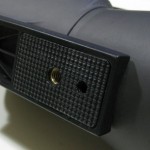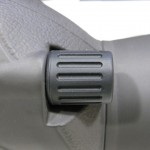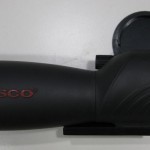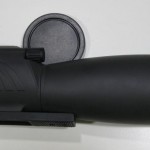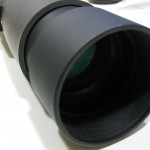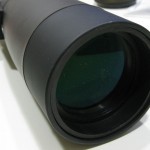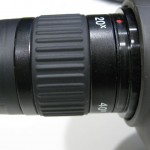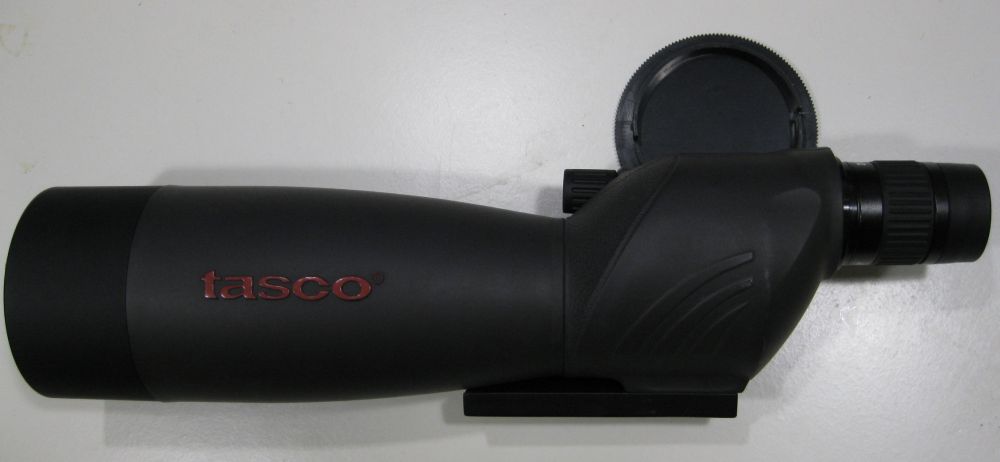
The Spotting Scope
Riflescopes are a bag of compromises. They need to be compact, sit low to the bore of the rifle, provide a range of very practical zoom, give enough eye relief that you won’t get scope eye, and above all else, they need to withstand the shock of firing the rifle. These compromises keep them from delivering the best clarity and highest magnification available at the lowest cost. A quick step up is a good set of binoculars, but beyond those, you’re in spotting scope territory. Most hunters use spotting scopes at a 100 yard range when sighting in their rifle, when scouting from long range, and some long range hunters use them to spot and watch prey before taking aim with their rifle. From a hunters perspective, a spotting scope should provide enough clarity to easily see bullet holes in paper at 100 yards, as well as enough zoom and resolution to watch game and identify sex/species/antlers/etc. I’m sad to say that the Tasco 20-60×60 is just not able to measure up.
Tasco 20-60X60 Spotting Scope
The Tasco 20-60×60 is an inexpensive spotting scope that’s widely available for around $100. It comes in a nice hard case with a soft carry bag, lens caps, and a little tripod. There’s nothing wrong with the carrying case, though the tripod is a bit hard to use. The big issue comes with the actual spotting scope, it’s just not clear enough. I’m no gun snob; I’ve got lots of . . .value priced equipment, but the Tasco 20-60×60 just isn’t suited for the tasks I had for it: easily find my bullet holes at 100 yards, and give me enough clarity to identify game at long distances.
At the Shooting Range
Right away, the supplied tripod does not give enough adjustability to sight in and set the spotting scope on your target. So, you’ll need another tripod and that’s not a really big deal. The spotting scope uses the same bottom screw mount that any camera would, so there are lots of inexpensive tripods out there that you can use. The thing I noticed right away at the shooting range was that it was not any easier to spot bullet holes with the Tasco Spotting Scope at ANY zoom compared with my Bushnell 10X40 Tactical riflescope, and it wasn’t even close to the Bushnell 6500. That Bushnell 10×40 should be easily outclassed by the Tasco, but it isn’t. Is it fair to compare a $250 rifle scope with a $100 spotting scope? I think so. If you can’t beat the clarity of a 40mm objective even when you stack the odds with a 60mm objective, there’s a quality issue. That 60mm objective should deliver tons of light, but the picture lacks brightness, even at 20X magnification. So, I put it away and just went back to using the 10×40 to spot holes in the target.
In the Field
OK, even a crappy image at 20X zoom is better than what your eyes can see. No doubt, if you were scouting and you didn’t have any optics, this spotting scope would do the trick, provided you had a really sturdy mount. The combination of short eye relief and a rubber eye cup means that you must contact the spotting scope to get a proper sight picture. That rules out any crappy tripod or ad-hoc rest that you might try to use, because slight movements from your head will affect the picture. I’ve had the eyepiece fog up on me a couple times on hot days when humidity from cramming my eye into the spotting scope fogged it up, as well as on cold days when it actually froze over. Not fantastic if you want to use it for long periods of time scouting out game.
Conclusion
Well, I found the money spent on this spotting scope could have been better if thrown in when buying a rifle scope. Personally, I think a great scope combined with an OK monocular or rangefinder gave me all the optics I needed. I use the rangefinder/monocular when I can’t quite make out what something is, and the scope when I know it’s a deer (and not a person or something I shouldn’t aim a rifle at). And at the range, I use my better quality scopes for finding those bullet holes in paper. What of the spotting scope? I found that on a sturdy camera tripod, it was awesome for star gazing and looking at the moon. Those far away craters really come to life at 40X, and the relative brightness of the moon shines through the mediocre optics of the Tasco. And unlike a traditional telescope, movements of the spotting scope move the picture accordingly, not in the opposite direction.
